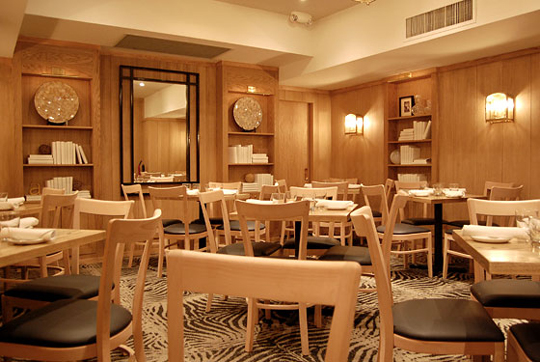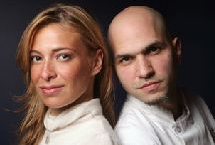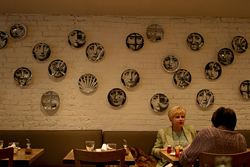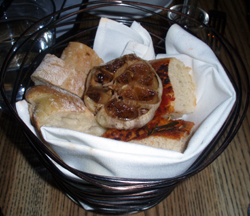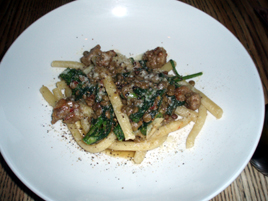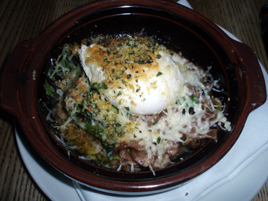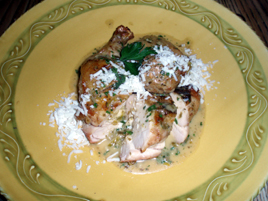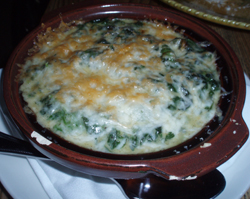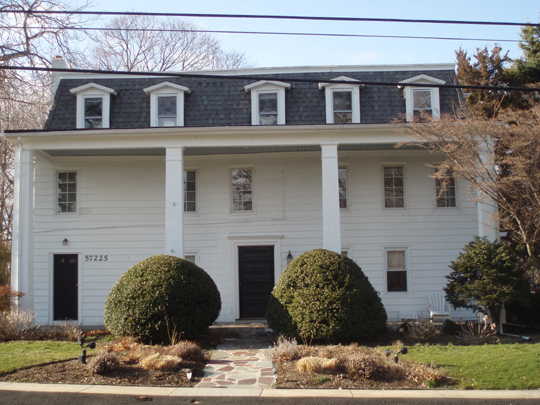
The North Fork Table & Inn is a charming bed & breakfast on the North Fork of Long Island, with a restaurant that has food addicts buzzing. It opened two years ago, after four Manhattan restaurant veterans decided they were sick of the big city.

Their credentials are impressive. Gerry Hayden (Aureole, Amuse) is executive chef. His wife, Claudia Fleming (Gramercy Tavern and numerous others), is pastry chef. Their partners, Mike and Mary Mraz (Hearth, Gramercy Tavern), run the front-of-house.
The upstairs had been a B&B under a succession of owners, while various French restaurants had occupied the dining room. The old building needed a gut renovation. The kitchen was too large, the bathrooms inconveniently located. One of the support beams was sagging.
As of 2006, it has all been redone in an understated post-colonial austerity. Both the dining room and the guest rooms are dominated by whites and light tans, with the walls mostly bare. The dining room is elegant and upscale, if you don’t mind floorboards that creak a little bit. There’s a handsome bar which can also accommodate walk-ins for dinner.

 The four guest rooms are large, comfortable, and recently renovated. There’s Wi-Fi access and a flat-screen TV. Each room has its own bathroom, also renovated.
The four guest rooms are large, comfortable, and recently renovated. There’s Wi-Fi access and a flat-screen TV. Each room has its own bathroom, also renovated.
The house actually has rooms on two levels, but alas, those on the third floor aren’t available to guests. Had they been renovated too, the North Fork Table & Inn would have been considered a hotel under the zoning laws, rather than a B&B, and a different set of building codes would have applied. The owners considered it, but the cost was prohibitive.
The restaurant garnered plenty of attention, including positive reviews from Andrea Strong, Gael Greene and Newsday. Dining there was the main reason for our trip, though we also took in wineries, visits with my girlfriend’s family, and dinner at another, equally compelling restaurant, The Frisky Oyster.

“Northforkopoly” (click to expand)
We chose to visit in late winter, mainly because we wouldn’t have had a prayer of getting in during the summer. Had we been bored, we could’ve settled in for a game of Northforkopoly, the local version of Monopoly (board and pieces supplied) though we’d need to have our heads examined if we could find nothing better to do.
We arrived to find bucket with a bottle of water on ice, but there’s no mini-bar or coffee maker. For that you have to go downstairs. Breakfast is served from 8:00–9:30 a.m., though when we wandered down much later than that, coffee and plenty of Fleming’s breakfast pastries were still available.
Dinner is served Wednesdays through Mondays, lunch Saturdays and Sundays. The lunch menu is similar to the dinner menu, though a bit less expensive and with smaller portions. At dinner, appetizers are mostly $12–18, though the foie gras starter is $25. Mains are $32–38. The five-course tasting menu is a bargain at $75, and though we didn’t order it, we noted that the portion sizes were generous. These prices are quite expensive by Long Island standards, and the restaurant is dependent on being regarded as a “destination” for out-of-town visitors.
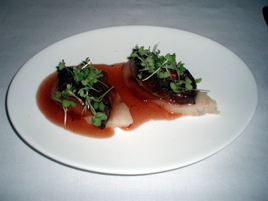
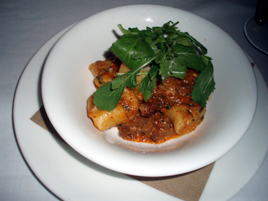
Raw Hamachi and Seared Foie Gras (left); Potato Gnocchi in a Braised Veal-Tomato Ragout (right)
The menu relies on locally sourced ingredients wherever possible, though in the winter practically everything came from elsewhere. Chef Gerry Hayden paired Raw Hamachi with Seared Hudson Valley Foie Gras ($25), accented with glazed daikon, radish syrup, mustard cress and fleur de sel. I’m not sure if it was a mistake or a considered decision, but the foie gras was more crisped than seared, but its warm, crunchy texture was a terrific foil for the hamachi.
My girlfriend had the Potato Gnocchi in a Braised Veal-Tomato Ragout ($15), which was rich and hearty, but made with a heavier hand than some of the better gnocchi we’d had in the city recently.
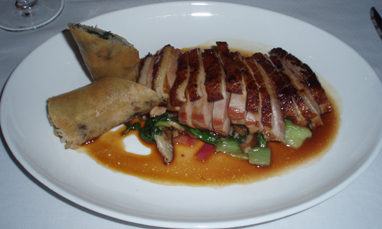
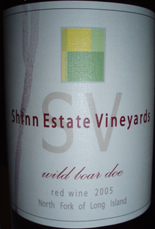
Long Island Duck Breast (left); Shinn Estate Vinyards “Wild Boar Doe” 2005 (right)
You can’t get any more local than Long Island Duck Breast ($34), which we both chose as our main course. It was painted with a wonderful soy-honey glaze, and the duck slices had a hefty rim of wonderful fat, but I didn’t see the point of the accompanying crisp jasmin rice roll, which was too dull to share the plate with such assertive company.
The wine list is brief and fairly priced. Keeping with our determination to drink only local wines, we chose the wonderful and wittily-named Shinn Estates “Wild Boar Doe” ($55), a blend of Merlot, Cabernet Sauvignon, Malbec, Petit Verdot and Cabernet Franc. Once again, we found that blends are dependable choices on Long Island, especially when you’re ordering a wine you’ve never heard of.
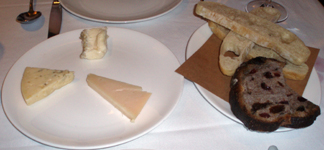
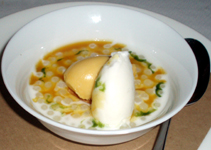
Cheese Plate (left): Coconut Tapioca (right)
We finished with the Cheese Plate ($12), which offered three American cheeses: a firm, raw sheep’s milk cheese from California, a crumbly raw cow’s milk cheese from Oregon, and a soft sheep and cow’s milk cheese from the Hudson Valley. The kitchen also sent out servings of the Coconut Tapioca with Passion Fruit Sorbet (normally $11), a terrific end to our meal.
I can’t close without commenting on a remarkable coincidence. A short while after we sat down, the table next to us opened up, and the next couple to arrive was the same couple that had been seated next to us at the Frisky Oyster. It’s not quite as improbable as if it had happened in Manhattan, but the chances of it happening are still awfully low.
Naturally we got to talking, and comparing notes about our meals on consecutive evenings. Which was better, the Frisky Oyster or the North Fork Table & Inn? The North Fork is fancier, more romantic, and more elegant. But what about the food? It’s awfully close, but several of us thought the Frisky Oyster had the North Fork beaten by a nose. Even between the four of us, we tasted only a fraction of the menus at both places, so it’s not a definitive judgment, by any means. You can have—check that, you will have—a terrific meal at either restaurant.
We loved our visit to the North Fork Table & Inn. The owners are outgoing and accessible. This is their passion, and they will do everything they can to make your visit a happy experience. Service is attentive and flawless, as you’d expect in a restaurant with so many Gramercy Tavern alumni in its midst.
We certainly hope to be back.
North Fork Table & Inn (57225 Main Road, Southold, Long Island)
Food: **
Service: **½
Ambiance: **½
Overall: **
 Thursday, March 27, 2008 at 12:07PM
Thursday, March 27, 2008 at 12:07PM  Galen Zamarra,
Galen Zamarra,  Mas in
Mas in  BruniBetting
BruniBetting 

